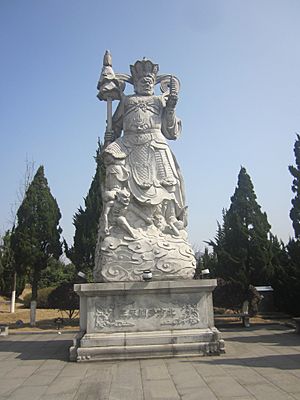Vaiśravaṇa facts for kids
Vaiśravaṇa (pronounced Vy-shrah-vah-nah) is an important figure in Buddhism. He is one of the Four Heavenly Kings, who are like special guardians. Vaiśravaṇa is known as a god of war and is often shown as a powerful warrior-king. He is also connected to wealth and good fortune.
Contents
What's in a Name?
The name Vaiśravaṇa comes from an old Sanskrit word. It means "son of Vishrava." He is also known by other names like Kubera and Jambhala. In different countries, people call him by different names:
- In China, he is called Duōwén Tiānwáng, which means "Heavenly King Who Hears Many Teachings."
- In Japan, he is known as Bishamonten or Bishamon.
- In Tibet, he is sometimes called Jambhala.
- In Thailand, he is called Thao Kuwen or Thao Wetsuwan.
Who is Vaiśravaṇa?
Vaiśravaṇa is based on an older Hindu god named Kubera. While they share some traits, they have different stories and roles in Buddhism and Hinduism. Even though he came to East Asia as a Buddhist god, Vaiśravaṇa also became part of local folk stories.
He is the guardian of the northern direction. His home is believed to be on a mythical mountain called Sumeru. He is also the leader of all the yakṣas, who are like nature spirits or guardians.
Vaiśravaṇa is often shown with a yellow face. He usually carries an umbrella or a parasol, which shows his power. Sometimes, he holds a mongoose that spits out jewels. The mongoose is seen as an enemy of snakes, which can represent greed. So, the jewels coming out of its mouth show generosity and giving.
Vaiśravaṇa in Different Places
In Theravāda Buddhism
In Theravāda Buddhism, Vaiśravaṇa is called Vessavaṇa. He is one of the Four Great Heavenly Kings. Vessavaṇa rules the northern part of the world. He is the leader of the yakṣas.
Vessavaṇa was once a rich man in Sri Lanka. He owned many mills and gave away a lot of his wealth to help others for 20,000 years. Because of his good actions, he was reborn as a Heavenly King.
Like all Buddhist gods, Vessavaṇa is a title, not just one person. When one Vessavaṇa dies, another takes his place. Vessavaṇa became a follower of Gautama Buddha. He protected the Buddha and his followers. He also shared special verses that Buddhists could use to protect themselves from harmful spirits.
In China
In China, Vaiśravaṇa is known as Píshāméntiān or Duōwén Tiānwáng. He is one of the Four Heavenly Kings and a protector god. He is often shown holding a pagoda (a tower-like building) in one hand and a trident (a three-pronged spear) in the other. You can often find his statue in temples, usually in the Hall of the Heavenly Kings. His name "Duōwén Tiānwáng" means he guards the place where the Buddha teaches.
In Japan
In Japan, Vaiśravaṇa is called Bishamonten or Bishamon. He is seen as a god of war and warriors, wearing armor. He punishes those who do wrong. Bishamon holds a spear in one hand and a small pagoda in the other. The pagoda stands for a special treasure house that he guards and shares. In Japanese folk stories, he is also one of the Seven Lucky Gods.
Bishamon is also called Tamonten, meaning "listening to many teachings." This is because he guards the places where the Buddha preaches.
In Tibet
In Tibet, Vaiśravaṇa is seen as a protector of the world and a protector of Buddhist teachings. He is known as the King of the North. You might see his image painted on temple walls near the main door. He is also considered a god of wealth. When shown as a wealth god, he might carry a citron fruit, which is a type of citrus. He is sometimes shown as a plump figure covered in jewels. His special animal is a snow lion. Tibetan Buddhists believe that Jambhala (Vaiśravaṇa as a wealth god) helps people gain wealth so they can focus more on their spiritual journey.
In Thailand
In Thailand, Vaiśravaṇa is known for helping to solve problems in old legends. There is a very popular large statue of him at Wat Chulamanee temple in Samut Songkhram Province. Many people visit this temple to worship him.
See also
 In Spanish: Vaisravana para niños
In Spanish: Vaisravana para niños
- Buddhism and violence
- Four Heavenly Kings
- Li Jing
- Seven Lucky Gods
- Hachiman
- Vasudhara








